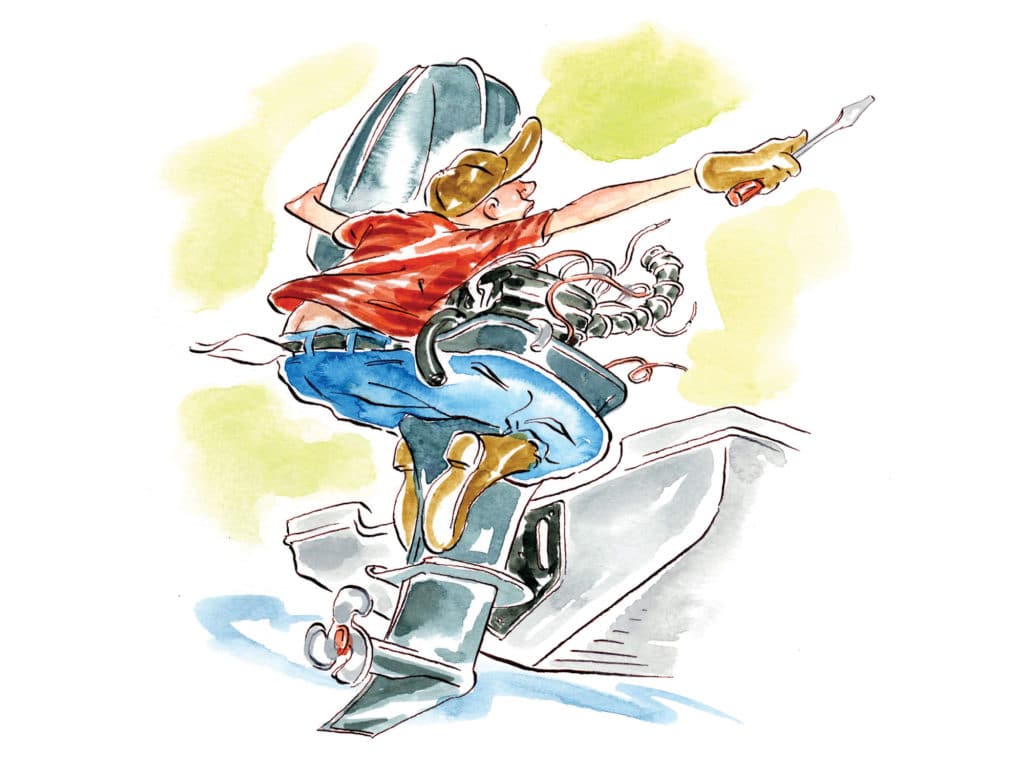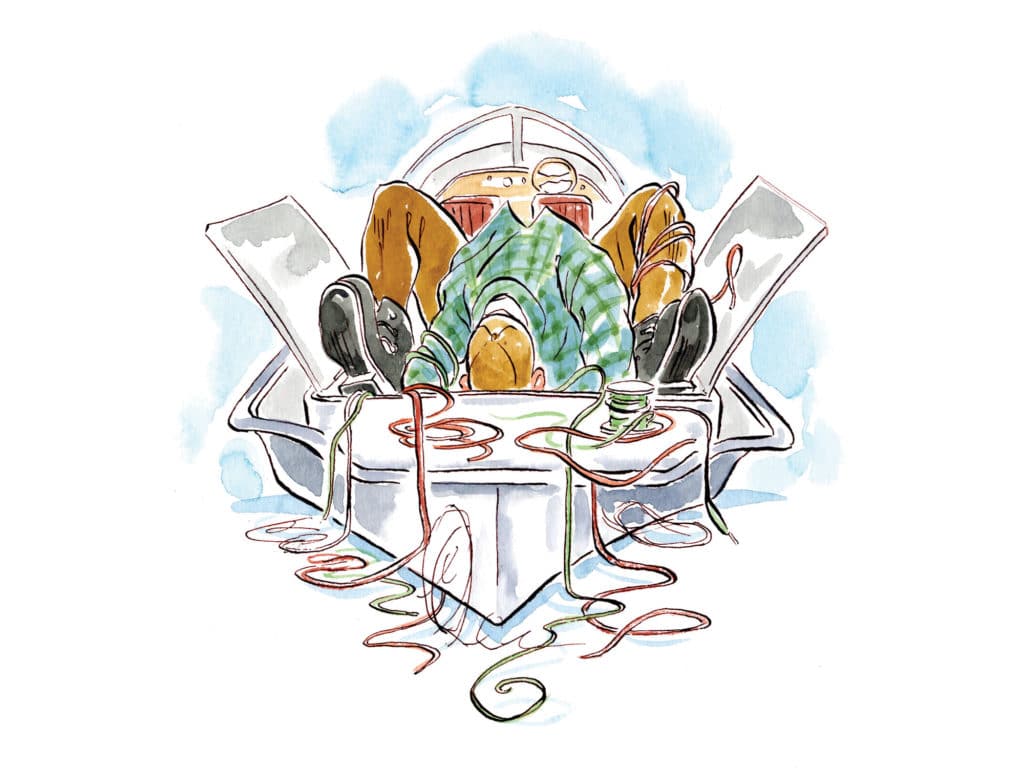
It’s that time of year again: Time to get the cover off the boat and get ready for summer fun on the water. If you are anything like me, you need a launch list to check off as you get the required tasks done and out of the way. I break down my list into five categories. Let’s take a look and make sure you have your vessel ready from top to bottom for the start of the new boating season.
Clean It
I always start at the scum line with an application of Marykate On & Off Hull and Bottom Cleaner to scour the hull bottom before applying any antifouling paint. Be careful: This stuff is hydrochloric-acid-based. Safety glasses and disposable gloves are important here. Paint it on with a disposable brush and rinse thoroughly with fresh water. Shop now
Paint It
Next, I mask off the waterline and apply a fresh coat of ablative multiseason, water-based antifouling paint. If you are switching to this type of paint from something else, be sure to check for compatibility with your paint manufacturer. Because my boat is on a trailer, I’ll jack it up off the trailer with a small hydraulic jack, block it, and paint the entire bottom in sections. (Water-based paint ensures easy cleanup.)
Wax It
I struggled for years with a power buffer and traditional wax application on my boat’s dark-blue hull — but no more. About three years ago, I switched to a spray-on ceramic finish after paying a professional detailer to give the hull a final power buffing. I can’t believe how great my 10-year-old hull looks. No more carnauba wax for my boat — it’s ceramic coating all day.

Oils and Filters
I’m going to assume you did the right thing and changed your engine oil and filter as well as your lower-unit oil before your boat was decommissioned for winter. If not, change your ways and do it now. This should always be done before extended layup.
You should have a water-separating fuel filter in your system. It needs to be replaced each season, and keep a spare on board—you never know when you’re going to pick up water when refueling. Shop now
Impeller Action
Every three years or 300 hours of engine operation, your water-pump impeller should be replaced. Also, look carefully at the bonding wires—the small stainless-steel, uninsulated wires connecting articulating parts on your engine. These have a habit of breaking and should be replaced if this occurs. These wires are important to minimize engine corrosion.
Anode Action
Check all the sacrificial anodes on your engine(s) and mounting bracket, and replace those that have lost half their mass. Shop now
Hose Health
It’s important to give things like fuel hoses and primer bulbs a close inspection. Any cracks or chafe points dictate immediate replacement.
Fit and Trim
Make sure all the grease fittings on the engine and tilt mechanism get a shot of fresh grease. Finally, apply that same ceramic coating you used on the hull to help keep that engine paint looking like new.

Battery Maintenance
Depending upon the size of your boat, you’ll have at least one battery, and probably more than one. These need to be clean and secured in the boat to eliminate any movement. If they are of the serviceable variety, the electrolyte level needs to be checked and topped up as needed. Most new batteries today are of the sealed or semi-sealed variety, and you can’t add fluid. In fact, removal of the caps can ruin the battery. Again, make sure the top of the battery is clean and dry. Oily, dust-laden deposits attract moisture, which can cause low-level electrical leaks from the positive post to the negative. Clean and dry is the order of the day. Make sure the battery clamps are tight and corrosion-free. Incidentally, if your battery cables are held on with wing nuts, they are no longer compliant with industry standards because they can loosen too easily. Replace these terminal connections with locking nuts. Shop now
Electrical System Checks
Ensure that all the electrical devices on board are working as they should. Check things like fuse panels and exposed electrical connections, looking for any sign of corrosion or loose connections. Any corrosion needs to be cleaned, and a small wire brush can do the job easily. I like to give fuse holders and terminal strips a light spray of Boeshield T-9 to help keep corrosion at bay. CRC and others offer corrosion inhibitors if you can’t find Boeshield T-9. As for loose connections, tighten any held with a hex nut, and any push-on terminals might need replacement. Make sure you use proper crimping pliers and the right-size terminal for the wire gauge in question. Shop now
Have any lights out? Check the bulbs, and get them replaced as needed.
Electronic Equipment Checks
Now is the time to check for any software or firmware updates to your equipment and install as needed. Make sure the software for your multifunction display, electronic charting and other equipment is the latest available and update if not. This can be confirmed with a visit to the manufacturers’ websites.
Transducers
If your fish-finder transducer is transom-mounted, make sure it aims straight down; these are typically designed to articulate to accommodate different mounting angles. Also, make sure there is no barnacle or other sea growth on the transducer’s surface. Transducer antifoulant is available at West Marine and should be used, especially if your boat stays in the water all season. Shop now
I use Pettit transducer paint, which is also good for use on stainless-steel trim tabs and the submerged part of my outboard engine trim and mounting bracket. Propspeed Foulfree also makes a good transducer coating system.
Radio Check
Double-check the coaxial cable antenna connection to your VHF radio, and make sure you have a clean and tight, corrosion-free hookup. Perform a radio check, and don’t use Channel 16! Channel 9 will do nicely here and won’t clutter the emergency channel. Shop now
Antennas
If you have already checked all your electrical-system connections, then you have confirmed good power and ground connections for your equipment. Do the same for any GPS antenna connections.

Canvas Snaps, Zippers and Tie-Downs
Get some Star brite snap-and-zipper lubricant, and use it to help with those stubborn snaps that resist coming undone just a little too much at times. It also keeps zippers running smoothly. Are the clear vinyl windows in your canvas getting a bit hard to see through? Get some Flitz plastic polish and a Flitz BuffBall. Use as directed to get things cleared up. Shop now
Upholstery Service and Care
Vinyl upholstery on boats lives a tough life. UV exposure will eventually attack and destroy it. I use 3M Vinyl Conditioner & Protector monthly as part of a routine maintenance schedule for the vinyl on my boat. So far, so good. I get a lot of compliments on how great the seats and cushions look.
Exterior Wood
Wood types and amounts vary considerably from one boat to another. The only wood on my boat, for example, is a beautiful Edson wood-rimmed steering wheel. As with vinyl, it lives in the sun, and UV rays will eventually get to it. I lightly sand and varnish it every two seasons to keep it looking like new. Obviously, this will vary quite a bit between boats, but keeping your exterior wood looking first-class is an important maintenance item.
Read Next: More Spring Make-Ready Tips

Simple Safety
If you ever get stopped by the US Coast Guard for a routine safety inspection, you need to make sure your flares are not out of date and you have approved life jackets on board for everyone in your party. If you are like me, you probably carry inflatable life jackets. Make sure the inflation cartridges are still in the green; if not, they’ll need replacement. Also, be advised that these jackets come in different sizes. Young children won’t do well in an adult-size life jacket. Because the flare dating is something I typically forget, I switched to one of the new Coast Guard-approved electronic flare sets last season. Remember, these are battery-powered, so make sure the batteries are up to snuff each season. Shop flares. Shop Life jackets.
Make sure you have the required number of fire extinguishers on board and that their charge gauges are in the green. Also, US Coast Guard regulations require a “sound-producing device,” such as a handheld air horn or athletic whistle. Although not mandatory, I also recommend having a first-aid kit to take care of minor injuries. Shop fire extinguishers. Shop air horns. Shop first aid kit.
Once you’ve completed your spring commissioning checklist, it might be tempting to head straight to the launch ramp and take off on an all-day nautical adventure. Before you do that, take a pre-trip — aka shakedown trip — to make sure everything is OK on the water before going on a real boat outing.
Make a plan to launch your boat and check for leaks or any issues, then give it a short test run to make sure all your hard work paid off and the vessel is ready for boating season.
Prepare to Launch
Ready to kick the boating season off in style with a smooth, hassle-free launch? With these 38 tips, you’ll be fully prepared when it’s time to get your boat in the water alongside your family and friends. Enjoy the peace of mind that comes with knowing your vessel is ship-shape and set for fun and adventure.









